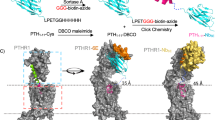Abstract
The evolution of endocrine systems has been intensively studied (for review see ref. 1). Recent findings indicate the existence of vertebrate-like hormones in primitive species including fungi and unicellular eukaryotes2–4. Although proteins that bind vertebrate steroids have been described in at least one lower organism5, the presence of recognition molecules analogous to hormone receptors in higher organisms has not previously been demonstrated. We have investigated Candida albicans and now report the existence of a receptor-like protein macromolecule in the cytosol of this simple yeast which binds vertebrate corticosteroids with high affinity, selectivity and stereospecificity. In addition, a lipid-extractable material present in the yeast cells and released into the chemically defined growth medium reversibly competes for 3H-corticosterone binding sites in yeast cytosol and may represent an endogenous ligand. Of interest is the finding that the yeast extract also competes for mammalian glucocorticoid receptors. The data suggest that the evolutionary origin of hormonal steroid systems may go back at least as far as simple unicellular eukaryotes. Furthermore, the demonstration of interactions between mammalian steroids and the yeast binder and between the yeast ligand and mammalian receptors suggests the possibility of important clinical consequences.
This is a preview of subscription content, access via your institution
Access options
Subscribe to this journal
Receive 51 print issues and online access
$199.00 per year
only $3.90 per issue
Buy this article
- Purchase on Springer Link
- Instant access to full article PDF
Prices may be subject to local taxes which are calculated during checkout
Similar content being viewed by others
References
Sandor, T. & Mehdi, A. Z. in Hormones and Evolution Vol. 1 (ed. Barrington, E. J. W.) 1–72 (Academic, New York, 1979).
Timberlake, W. E. Devl Biol. 51, 202–214 (1976).
LeRoith, D., Shiloach, J., Roth, J. & Lesniak, M. A. Proc. natn. Acad. Sci. U.S.A. 77, 6184–6188 (1980).
Katzanellenbogen, B. S., Katzenellenbogen, J. A. & Mordecai, D. Endocrinology 105, 33–40 (1979).
Watanabe, M., Phillips, L. & Chen, T. J. Steroid Biochem. 4, 613–621 (1973).
Funder, J. W., Feldman, D. & Edelman, I. S. Endocrinology 92, 994–1004 (1973).
Feldman, D., Funder, J. & Loose, D. J. Steroid Biochem. 9, 141–145 (1977).
Scratchard, G. Ann. N. Y. Acad. Sci. 51, 660–672 (1949).
Philibut, D. & Raymond, J. P. in Progesterone Receptors in Normal and Neoplastic Tissues (eds McGuire, W. L., Raymond, J. P. & Baulieu, E. E.) 227–243 (Raven, New York, 1977).
Author information
Authors and Affiliations
Rights and permissions
About this article
Cite this article
Loose, D., Schurman, D. & Feldman, D. A corticosteroid binding protein and endogenous ligand in C. albicans indicating a possible steroid-receptor system. Nature 293, 477–479 (1981). https://doi.org/10.1038/293477a0
Received:
Accepted:
Issue Date:
DOI: https://doi.org/10.1038/293477a0
This article is cited by
-
Nocardia brasiliensis: in vitro and in vivo growth response to steroid sex hormones
Mycopathologia (1995)
-
The effect of selected human steroid hormones upon the growth of dermatophytes with different adaptation to man
Mycopathologia (1992)
-
Cryptococcosis of the nasopharynx in mice and rats
Mycopathologia (1988)
-
Effect of growth of Candida spp. in the presence of various glucocorticoids on the adherence to human buccal epithelial cells
Mycopathologia (1987)
Comments
By submitting a comment you agree to abide by our Terms and Community Guidelines. If you find something abusive or that does not comply with our terms or guidelines please flag it as inappropriate.



